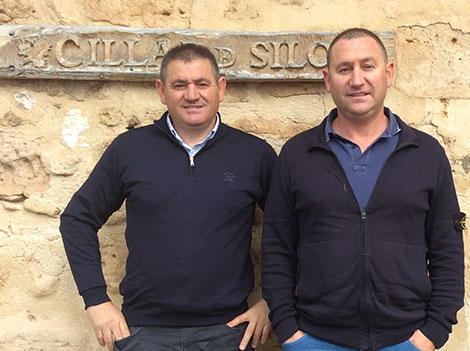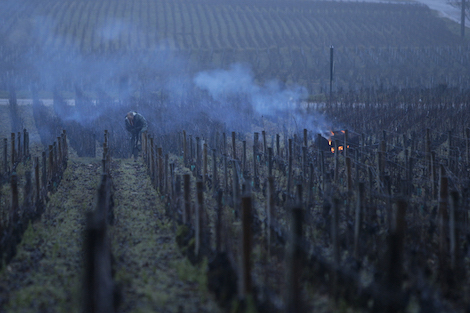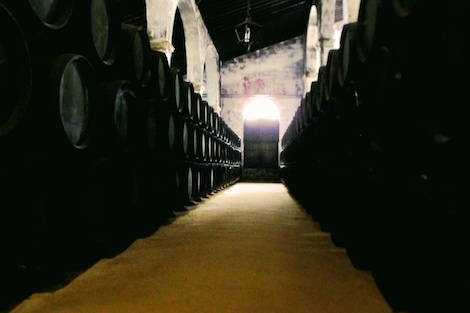Dominio del Pidio: bringing new styles to Ribera del Duero

Brothers Roberto and Óscar Aragón are not among the best known wine producers in Ribera del Duero. Their winery, Cillar de Silos, may neither be among the top names in the area, but their new project, called Dominio del Pidio, could very well lift them onto the premier league together with the excellent single-vineyard reds that they have been producing in the appellation for a good number of years.
Dominio del Pidio favours a return to traditional winemaking in Ribera del Duero with fermentations in concrete vats (winemaker Óscar Aragón believes it has considerable impact in the style of the wine), the addition of small amounts of white Albillo to reds (the family already did this in their Torresilo red) and wine aging in ancient underground cellars. In this way, Dominio del Pidio goes well beyond the style and aims to recover the old locations where wine was made in the past.
Concrete, caves and monks
It has taken over seven years to purchase five lagares (ancient wine presses) and seven underground cellars in the old bodega district of Quintana del Pidio (Burgos), the small village near Aranda de Duero where Cillar de Silos is located. Ownership was so widely spread that contacts had to be made on a one-by-one basis. Over 70 purchase agreements were signed before restoring the ancient caves where all the Dominio del Pidio wines will be made from 2018 onwards.
The bodega district in Quintana del Pidio dates back to the 16th century. The village had actually been a priory of Santo Domingo de Silos monastery –the Aragón family named its winery after this religious community– ever since King Alfonso VIII handed over the town to the monks in 1190 in exchange for a piece of land near Tordesillas. The monastery’s accounting books registered an entry of 200 large pitches of wine from the village of “Quintana de Arpidio” as early as 1338.
The painstaking restoration has brought to light a large old beam press, a couple of 3,000-litre wooden casks which will be left on the spot for decorative purposes and many concrete vats where local winegrowers used to produce their own wines before local cooperatives were set up during the 1950s and 1960s, a move that meant the abandonment of these bodega districts. Many of the existing concrete vats will be used again as well as other new, smaller tanks bought to fit the reduced volume of the project.
Aging wine underground
As shown on the back labels, Dominio del Pidio will make village wines from 10Ha of old vines grown in Quintana del Pidio. Production is meant to be limited to 50,000 bottles, including 5,000 bottles of rosé and 5,000 of white. Despite these figures, production was shorter initially and the wines were made in Cillar de Silos. The red was first made in 2014 whereas the first white and rosé vintage was 2015.
The Aragón brothers are well aware of the benefits of underground aging. Some time ago, they bought and restored two old cellars in the village in order to age the best bottles made at Cillar de Silos. Inspiration came from Paternina’s ancient cellars in Ollauri (Rioja) —Óscar worked for Bodegas Franco-Españolas between 1988 and 1993 at a time when both wineries where owned by Rioja entrepreneur Marcos Eguizábal.
“Temperature is always between 12ºC-13ºC with humidity levels around 78% and the atmosphere is clean without damp or mould,” explains winemaker Óscar Aragón. It means extra work because bottles must be moved by hand, but the slower evolution of wine compensates the effort. In the case of Dominio del Pidio the entire process, from fermentation to bottling and aging, will be done this way.
Albillo: the missing link
Dominio del Pidio represents a more complex and varied vision of Ribera del Duero with the presence of Albillo (Albillo Mayor to be precise or Torrontés as it is called in Rioja), a white grape that used to be planted with red varieties and blended with Tempranillo. The basis for this practice has to do with gaining acidity and the stabilization of colour but in Ribera there is a clear link to Tempranillo’s increasingly worrying high pH levels.
“We are very lucky that pH levels for Albillo in the area stand at around 3.2, which helps to to control this issue”, says Óscar Aragón. In this regard, he likes to keep pH levels under 3.8. If adjustments are needed, tartaric acid is added to the grapes prior to fermentation. “The only secret is to look after our fruit, handle it with care, pick grapes relatively early and add some white grapes in our reds”, he concludes.
The shortage of white grapes and the fact that white wines cannot bear the Ribera del Duero seal has not prevented producers from releasing a relatively large number of Albillo-based whites over the last few years.
The Aragón family, who is planting Albillo grapes, has two white wines in the market. Cillar Blanco de Silos (5,000 bottles, €14.90 at La Casa de los Quesos) is a straightforward, sharp version with good acidity together with aniseed and white fruit aromas. After fermenting the wine in stainless steel tanks, 15% of it is aged in 500-litre oak barrels for six months. The new Dominio del Pidio (€49.55 at Ulzama) offers more complexity, volume and depth. As is the case with the whole Dominio del Pidio range, it is fermented in concrete vats but 50% of the wine is aged in 500-litre oak barrels for eight months. There is an interesting oxidative nuance and stone fruit character in the wine and the palate feels more unctuous with a creamy texture and nicely wrapped-up acidity.
Dominio del Pidio rosé (under 3,000 bottles, €24.10 at Vilimun) blends Albillo and Tempranill in order to showcase dried-herb, aniseed and aromas and the zesty acidity provided by this white grape.
Expanding wine styles in Ribera del Duero
The change of style is particularly evident in Dominio del Pidio red when compared to other reds from the area or even to Cillar de Silos’ traditional range. The first 2014 vintage of Dominio del Pidio (5,200 bottles, €48.30 at Vilimun) clearly shows less extraction and a low-tech approach. Aging takes place in 225- and 500-litre oak barrels so the wood character is muted. The fruit is less jammy; spicy aromas play a relatively important role and the earthy, slightly rustic edge adds a touch of authenticity. It comes close in style to recent vintages of Peter Sisseck’s PSI and the most aerial wines by Dominio del Águila from the nearby village of La Aguilera. The riper, more concentrated 2105 vintage has more liquorice and black fruit and will arguably please traditional Ribera del Duero drinkers.
Despite its moderated extraction and oak treatment, Cillar de Silos’ high-end reds feel rounder and fuller on the palate. Old-vine Torresilo (€ 32.90 at Bodeboca, 23,000 bottles) is a classic smart buy in terms of terroir-driven Riberas. I find particularly interesting the contrast between the elegance of Flor de Silos (around 5,000 bottles, €37.12 at Vinósofos) and the concentration of La Viña de Amalio (slightly over 2,000 bottles, €39.95 at Vinos Ribera). Flor grapes are sourced from the family’s highest plot planted at 900m of altitude on sandy stony soils. La Viña de Amalio is named after Roberto and Óscar’s father who planted this northwestern-oriented vineyard in 1964 on clay sandy soils.
With a rich diversity of soils, altitude and wine landscapes, Ribera del Duero should deliver a wider variety of styles. And as Cillar de Silos has proved, many producers have the experience and the background to go beyond the overwhelming, yet monolithic profile of power, fruit bombs and oak. Diversity is highly welcomed.

Amaya Cervera
A wine journalist with almost 30 years' experience, she is the founder of the award-winning Spanish Wine Lover website. In 2023, she won the National Gastronomy Award for Gastronomic Communication
NEWSLETTER
Join our community of Spanish wine lovers






